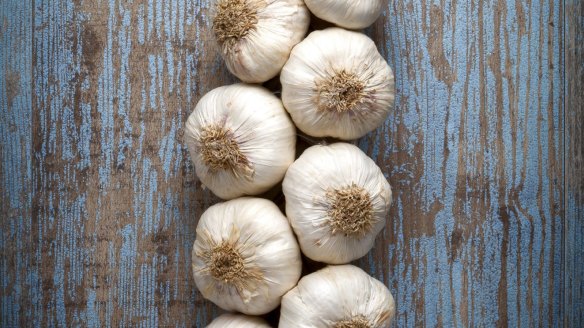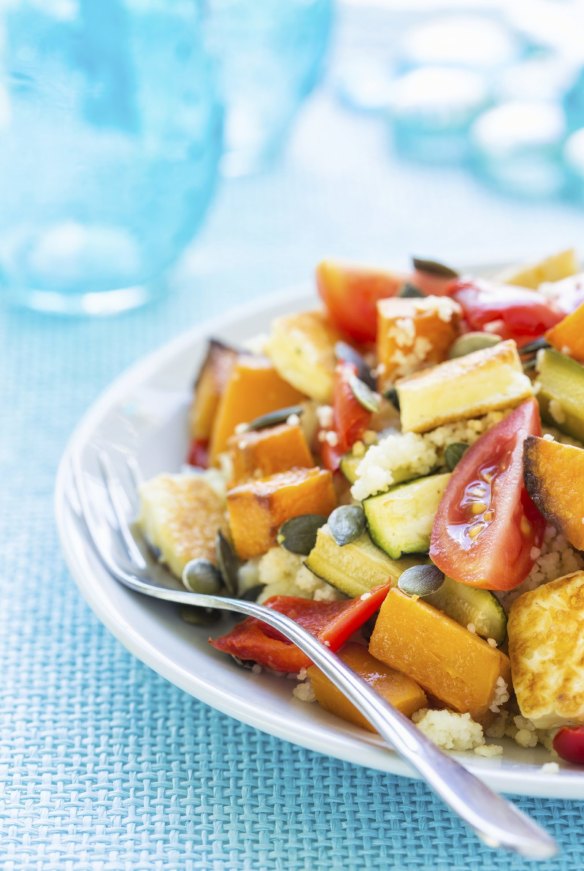Gardening advice: How to grow garlic in Canberra

There are some vegetables which need to be planted at just the right time and garlic is one. It is a slow growing plant which needs to establish itself well before the soil temperatures drop in mid winter. The other key point is that a garden bed needs to be prepared well and be kept weed-free to produce a bountiful crop, come the beginning of summer.
Prepare well and plant on time are the two key elements but then you should also seek out good quality Australian grown "seed". Do not try to grow garlic from imported, fumigated bulbs which have been rendered sterile by the methyl bromide and all too often sprayed with nasty chemicals during the growing season.
There is a good selection which range from white, to stripy pinks and deep purple skins. Some mature earlier than others and all have a distinct flavour. Some varieties are strong and pungent, yet others are quite mild to eat so that children can enjoy eating their own homegrown garlic.

Source your garlic from a reputable local supplier and grow varieties that are known to grow well in cold climates. There are now over 40 varieties being grown around Australia but those which are suitable for Queensland are not very suitable for the colder regions.
There are two main groupings of garlic varieties, the hard neck and the soft neck. The red and purple hard neck garlics will mature more quickly than the soft neck garlics but they will not store as well. The hard neck garlic and produce scapes - the long stalk with a curled looping end, crowned with a little bulbil. The bulbils are clones of the mother plant and can be used in cooking or kept for later planting.
Local growers have been finding the best results come from growing Italian Red, Italian White and Monaro Purple. These are the varieties that you will mostly find being sold over the summer months in the Farmers Markets around Canberra. Ingelara Garlic have good supplies of the Monaro Purple at the Capital Region Farmers Market for planting now.
Back to preparation and planting. You can expect to produce 1kg of garlic from the cloves of two to three garlic bulbs. Most of the mainstream varieties have between 7-10 cloves per bulb. Garlic is a member of the allium family (which includes onions and shallots) so you really should follow a four year crop rotation. It is good to plant as a follow on crop to where you have grown potatoes or tomatoes in the past summer. After you harvest your garlic in the coming summer, plant out a crop of beans or snow peas.
Garlic plants have a very extensive fibrous root system for seeking out nutrients in the soil and drawing in moisture. So make sure that you are providing compost, enriched beds that have a depth of at least 50cm.
Garlic struggles with weeds and with wet conditions. The best preparation is to plant a green manure crop and dig it in before planting your garlic. (It is too late to make such preparations for this year but you can diarise for 2017). Dig in plenty of compost and sprinkle some gypsum over the ground.
Garlic takes seven to eight months to grow and mature. During this time, you will have one or more heavy rain periods. The only way to stop your garlic from rotting off is to make sure that you have shaped your garden bed well at the time of planting. It is so disheartening to nurture the little plants for months and months, only to then have them become waterlogged with a late winter or spring downpour and for the bulbs to quickly rot.
Hill up your beds to around 25 cm and level off the tops of the rows to remain wide enough plant a double row of garlic seed. Provide 8-10cm between each pair of garlic seed and allow 20-25 cm between rows, so that you can walk along to weed and mulch your emerging garlic plants. So you can aim for around 60-70 garlic plants per square metre.
Separate your seed bulbs only when you are ready to plant. You can expect to get 7-8 good sized cloves from each medium to large garlic bulb. Do not throw away the smaller cloves but plant to plant them out in their own bed to be harvested early as spring garlic. You can plant these smaller cloves about 4-5cm apart as they will be harvested before the bulbs begin to expand.
Garlic will be ready to harvest in early December. Plan to turn over the stems as they begin to dry. Then dig out carefully with a garden fork, so that the bulbs can draw down the remaining nutrients from the leafy stems and remain intact until you wish to use the new season bulbs in the kitchen.
Roast Vegetables with Garlic and Couscous
2 onions
2 shallots
3 medium carrots
2 parsnips
4 tbsp extra virgin olive oil
4 cloves garlic
2 red chillies
1 tsp paprika
½ tsp ground cinnamon
½ tsp coriander seeds, crushed
½ tsp cumin seeds, crushed
600 gms Roma tomatoes
2 zucchinis
salt
freshly ground black pepper
1/3 cup vegetable stock
500g couscous
80g butter
1 bunch parsley, chopped
1 bunch coriander, chopped
Peel and slice the onions, shallots, carrots and parsnips. Peel and crush the garlic and finely slice the chillies. Slice the tomatoes and zucchinis.
Heat the olive oil in a heavy based pan over medium heat. Place the onions, shallots, carrots and parsnips in the pan, stirring regularly. Cook for around 10 minutes, until golden. Add in the garlic, chillies and spices and mix well with the vegetables. Cook on medium heat for a further 4 minutes. Add in the tomatoes and zucchinis and season with salt and pepper. Transfer into a casserole dish, add in the vegetable stock and bake in the oven at 180°C for 35-40 minutes.
Pour the couscous into a large bowl and cover with boiling water. Mix well and allow to stand for 8-10 minutes. Melt the butter in a small saucepan and add in the parsley and coriander. Cook for 1 minute and then pour over the couscous. Mix in well.
Remove the vegetable dish from the oven and drizzle with olive oil. Serve with the couscous.
This week in the Garden
Plant snow peas, shelling peas and broad beans in all of the spare spaces in your garden to provide early spring crops and to enhance your soils with their nitrogen fixation properties.
Plant out a row of leek seedlings along with your garlic plantings. Keep on planting out a small supply of rocket, radish and loose leaf lettuces.
Other green manure crops can be planted now to build your organic matter content for the next spring and summer crops. The crops could include a mix of fenugreek, mustard, oats, pod vetch and sub clover. Allow them to grow through the winter months then dig them into the garden beds before they flower.
Rake up leaves as they fall and add to the compost. Mix in with some green vegetation and animal manures. Turn the compost regularly and ensure it has sufficient moisture for the heat to build.
Owen Pidgeon runs the Loriendale Organic Orchard near Hall.